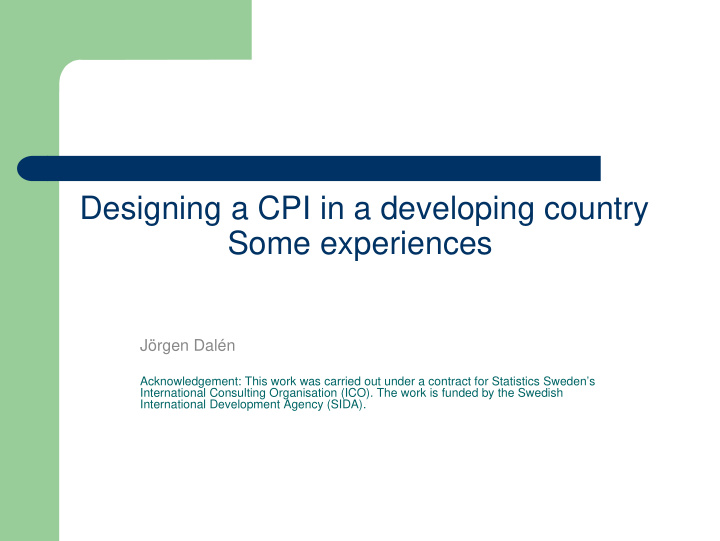



Designing a CPI in a developing country Some experiences Jörgen Dalén Acknowledgement: This work was carried out under a contract for Statistics Sweden’s International Consulting Organisation (ICO). The work is funded by the Swedish International Development Agency (SIDA).
Background CPI manual an important reference document � But short on specific advice and recommendations – Many small/medium developing countries in the world with similar conditions which need more concrete, – specific advice. El Salvador: � Small country with 5.7 million people in Central America and a small land area. – Economy divided between a modern sector and a traditional sector – Staff resources: 33 including 25 price collectors and 6 with academic training – Project is a complete CPI redesign based on a new HBS. This presentation includes a � selection of issues: Product selection and outlet sampling – Elementary aggregation and selection of product offers – “Monthly pseudo-chaining” – Replacements – Special products – Central price collection –
Product selection and outlet sampling � Use amount of expenditures as the main guiding principle for product selection. Products with more than, say, 0.1 % of total expenditure should – normally be included Those below, say, 0,05 % should normally be grouped together to – be represented by one of its members, with the relatively largest expenditure. � Sample sizes proportional to product weight, is a robust rule of thumb, if standard deviations are not fully analysed. Allocation rules complex since different aggregation levels and – time horizons (12-month, 1-month etc.) are involved Over-allocation of products with known volatile prices (fresh foods – such as fruits and vegetables) and Under-allocation of products with more stable prices (household – durables) could complement this rule .
Elementary aggregation and selection of product offers � The geometric mean should be used � The most sold criterion should then be applied in each outlet – within a wide product specification – in order to achieve maximum representativity of the sample. – An old tradition asks for tight, homogeneous specifications. Motivated by the use of the Dutot formula but not when Jevons is used – (This is another advantage of Jevons over Dutot, since it allows for a more representative sample.)
“Monthly pseudo-chaining” � Monthly pseudo-chaining is a useful calculation technique that facilitates the handling of non-comparable replacements and overlaps. � A separate calculation is done between each two consecutive months, which is then linked to the index for the last month according to: (par. 9.84 of CPI Manual) � Without pseudo-chaining, new base prices for the initial � base period will have to be imputed each time non- comparable replacement occurs, which is a much more complex procedure to implement � The algebra around the this procedure is simple but needs to be spelled out and explained
Replacements � Distinction between comparable and non-comparable replacements – Comparable go into the index without adjustment – Non-comparable are excluded – Easy to criticize on theoretical grounds – Yet, for most products (not cars and PCs) it appears to work comparatively well in practice (IQI analysis) – Not easy to devise a better method for a country with limited staff resources. � Exclusion of temporarily reduced prices is a way to avoid “clothing bias” caused by the end-of-sale reductions – In El Salvador we apply this rule for all products except technological products
Special products � Simple user profiles are a useful method for covering mobile phone tariffs Mobile tariffs appear to have the same complexity everywhere! – Difficult method but no simpler one could provide reasonable – index? Data on mobile phone use and expenditure available in HBS. – � The monthly chaining method is a practical and robust method for PCs. It needs to be carefully implemented, however. – In each outlet a number of models needs to be followed. – New models have to be introduced each time an old model – disappears. The basis for the introduction of new models must be large sales – value and not similarity with outgoing models. Hedonics is too complicated for many countries. –
Central price collection � Central price collection for certain products, where prices are not easily observed in outlets should be used. – It is important to realize the presence of weight and other useful information existing in websites of companies, regulatory agencies etc. – Used for education, electricity, cars, water and sewage, airfares, bus fares …

Recommend
More recommend